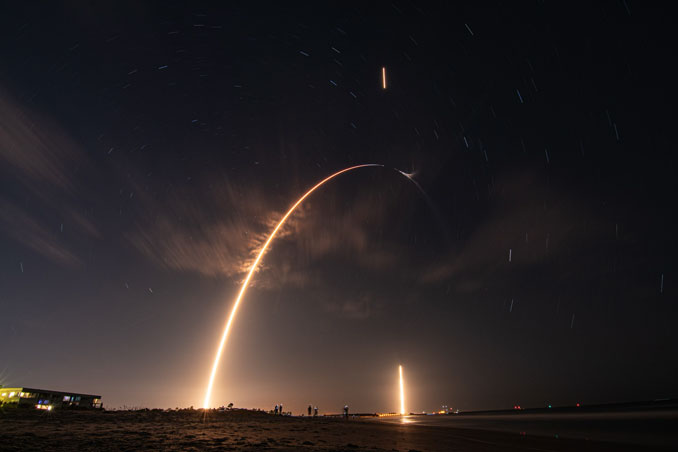
A long-exposure from the beach at Cape Canaveral captures the first-stage and second-stage burns, plus the entry and landing burns of the first-stage. Image: Michael Cain/Spaceflight Now.
November 16, 2023, 12:55 pm EST
From: Dr. Jeff Goldstein
Student Spaceflight Experiments Program (SSEP) National Program Director
Center Director, National Center for Earth and Space Science Education
The 38 flight experiments comprising the Orbiter payload for Student Spaceflight Experiments Program (SSEP) Mission 17 are now being operated by the astronauts aboard the International Space Station. The Orbiter payload also contains the Mission 17 and Mission 14 flight Mission Patches.
The Mission 17 Orbiter payload launched aboard SpaceX CRS-29 (SpaceX Commercial Resupply Service Mission 29) on Thursday, November 9, 2023, at 8:28 pm EST from Launch Complex 39A (LC-39A) at NASA’s Kennedy Space Center, Florida. About 7.5 minutes after launch the first stage landed back at Kennedy Space Center.
In the long exposure photo above courtesy of Spaceflight Now, three milestone events taking place at different times are visible. At the bottom of the photo is the launch of SpaceX CRS-29. At the top, the first stage separates from the combined second stage and Dragon vehicle. The arc is the first stage returning to Earth and landing at Kennedy Space Center.
The Dragon vehicle docked with the International Space Station on Saturday, November 11, 2023, at 5:07 am EST.
On Tuesday, November 14, 2023, 11:34 am EST, the National Center for Earth and Space Science Education received official word from Nanoracks, the SSEP payload services provider, that European Space Agency (ESA) astronaut Andreas Mogensen initiated the first Mission 17 experiments earlier in the day starting at 4:50 am EST. Mission 17 student flight teams are now conducting their ground control experiments concurrently with the flight experiments on ISS. Concurrent operations are being undertaken via the SSEP Mission 17 to ISS: Experiment Log page, which details all astronaut interactions with the experiments.
Note that the Mission 17 ‘countdown’ clock in the right column is now counting up. This clock provides the elapsed time since launch.
The videos below provide coverage of multiple events from launch to Dragon docking at ISS.
To all SSEP Mission 17 Student Flight Teams, your experiments are now being operated by the astronauts aboard the largest spacecraft ever constructed, orbiting our home world at an altitude of 250 miles and traveling at 18,000 mph. Every 90 minutes your experiments complete an orbit of Earth – traveling over 25,000 miles. Yes, this is all very real. Congratulations for a job well done.
To all Mission 18 communities in the midst of flight experiment selection by the SSEP Step 2 National Review Board, consider this a dry run.
NASA Coverage Begins at T-30 minutes
SpaceX CRS-29 Launch
First Stage Separation – First Stage Heads Back for Landing at Kennedy Space Center
First Stage Landing at Kennedy Space Center
SpaceX Dragon Nosecone Separation
Dragon Docking at ISS
The Student Spaceflight Experiments Program (SSEP) is a program of the National Center for Earth and Space Science Education (NCESSE) in the U.S., and the Arthur C. Clarke Institute for Space Education internationally. It is enabled through a strategic partnership with NanoRacks LLC, which is working with NASA under a Space Act Agreement as part of the utilization of the International Space Station as a National Laboratory. SSEP is the first pre-college STEM education program that is both a U.S. national initiative and implemented as an on-orbit commercial space venture.
The Smithsonian National Air and Space Museum, and the International Space Station (ISS) National Laboratory, are National Partners on the Student Spaceflight Experiments Program.

Comments are closed.